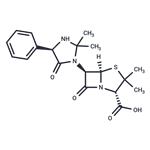Description
Hetacillin was synthesized by Bristol-Myers
Laboratories in 1964. It shows activity as strong
as that of ampicillin against a variety of
gram-positive and gram-negative bacteria.
Hetacillin shows almost the same pharmacokinetic properties as ampicillin when administered
orally and a later serum peak when given by intramuscular administration. When administered
either orally or intramuscularly, it is hydrolyzed
in vivo into ampicillin. Therefore, the clinical
applications of hetacillin are the same as those
of ampicillin.
Originator
Natacillin,Bristol Banyu,Japan,1970
Uses
Hetacillin is a β-lactam antibiotic.
Definition
ChEBI: Hetacillin is a penicillin. It has a role as an antibacterial drug. It is a conjugate acid of a hetacillin(1-).
Manufacturing Process
To 100 grams of α-aminobenzylpenicillin slurried in 2,500 ml of acetone is
added 200 ml of a 22% solution of potassium ethylhexanoate in dry n-butanol
and the mixture is warmed to 45°C whereupon the acid dissolves. After the
mixture is agitated for 1 hour at 40° to 45°C, the product begins to crystallize
out. Agitation is continued for 4 hours at 45°C after which the product, the
potassium salt of hetacillin, is collected by filtration, washed with 500 ml of
dry acetone, dried for 17 hours at 40°C and found to weigh 70.0 grams.
brand name
Versapen-K (Bristol-Myers Squibb)
.
Therapeutic Function
Antibacterial
![7-(2,2-DIMETHYL-5-OXO-4-PHENYL-IMIDAZOLIDIN-1-YL)-3,3-DIMETHYL-6-OXO-2-THIA-5-AZABICYCLO[3.2.0]HEPTANE-4-CARBOXYLIC ACID Structure](https://www.chemicalbook.com/CAS/GIF/3511-16-8.gif)
